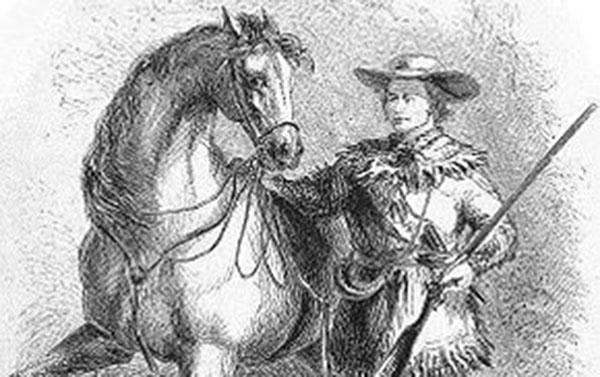Kit Carson spent years helping stop the “Indian Uprisings” and to create a safe environment for white American settlers, unfortunately at the expense of native Americans.
Christopher Carson was born on December 24, 1809 in Madison County, Kentucky and raised in Missouri where his family relocated in 1811. His father Lindsay was a farmer and a veteran of the Revolutionary War and died in an accident when Kit was a young boy. Kit’s large family was financially devastated by the loss of the head of their household and Kit was forced to give up his education and work on the farm and hunt to help support the family.
Kit Becomes a Frontiersman and Trapper
At the age of fourteen, Kit became apprenticed to a saddle maker but after two years he decided that saddle making was not the career for him and signed on with a caravan going to Santa Fe New Mexico.
Kit worked as a horse and mule tender until the winter of 1826 when family friend Matthew Kinkead seeing young Carson’s enthusiasm for the outdoors, instructed Kit in the art of trapping.
At this time Kit came into constant contact with native Americans and became interested in learning their languages. He became fluent in at least seven native American tongues as well as Spanish. Kit trapper for several years and became a premier frontiersman and skilled trapper.
In 1829 he joined a trapping expedition into Apache territory where he killed his first man, an Apache Warrior who was part of a raiding party that attacked the forty-man trapping party. In 1835 at the age of twenty-five he gained notoriety among other mountain men and trappers because of a feud fought over an Indian woman named “Singing Grass” whom he would later marry.
Kit continued to trap along the Yellowstone and Big Horn Rivers and fathered his first child in 1837, a second daughter was also born between 1838-1840 and Singing Grass died shortly thereafter. Kit would ultimately marry three native American women and father ten children.
Manifest Destiny
The United States was in a period of growth and in 1842 and later in 1843 Kit accepted a job as a guide for John Fremont on an exploration of uncharted U. S. territory. They traveled through the Great Salt Region and into the Oregon territory where they charted the unsettled regions of the Pacific Northwest and took in the sights of Mount Hood and further north to Mount Rainier.
Reports made to President Polk in Washington D.C. about the open virgin regions prompted westward expansion and later a conflict with the Country of Mexico as well. Kit would come into conflict many times with native American’s who were upset about encroachment from white’s who were increasingly becoming more aggressive and claiming more and more of their native lands.
Kit continued to work with Fremont and became embroiled in the fight over the territory that would eventually became the U.S. State of California. U.S. soldiers became involved in fights with Mexican troops in San Diego, and Los Angeles and in 1846 Fremont was appointed Governor of California.
The U.S. Civil War
In 1861 the U.S. Civil War broke out and Kit quit his job as a federal Indian agent in New Mexico to join the Union Army under Colonel Edward Canby. The majority of western states were busy trying to squelch Indian uprisings but one notable conflict Carson was involved in was the “Battle of Valverde.”
Confederates led by General Henry Sibley from Texas invaded New Mexico and clashed with Canby’s troops. The New Mexican volunteers lost the battle and Kit’s troops lost sixty-eight men and one-hundred and sixty wounded.
The Battle of Adobe Walls and other Indian Uprisings
In 1862 the Navajo Indians in New Mexico were in a constant state of agitation and were conducting raids upon the whites. Colonel Canby was promoted and replaced by Brigadier General James Carleton. Kit remained in service with Carleton who was determined to crush the Indians once and for all.
Kit clashed with Carleton on many occasions when Carleton’s policies and actions were too harsh and appalling. But Kit was a loyal soldier and eventually accepted the inevitability that more drastic measures were required to win the war against the Navajo and implemented Carleton’s “scorched earth policy” by burning homes, orchards, and fields.
In 1864 Carson was involved in the “Battle of Adobe Walls” on the Texas Panhandle in a battle with Native forces and was commissioned by Carleton to help smash the uprisings there. Although Carson was a renowned soldier and Indian fighter he respected them and was appalled by the “Massacre at Sand Creek” in Colorado when over four-hundred Cheyenne men, women, and children were killed.
Kit Carson was an honorable man caught up in a time where his duty often forced him to cross the line between what was right and what was required to get the job done. Although famous for his violent and sometimes harsh actions against native Americans during times of war, he was a soldier and a patriot who did his duty and served with distinction.
Kit retired from the army after the Indian rebellions were over and became a farmer and fathered ten children in his lifetime and died May 23rd 1868 at the age of fifty-eight of heart problems.








